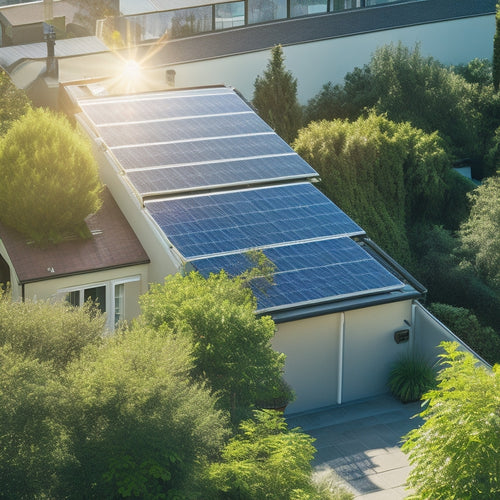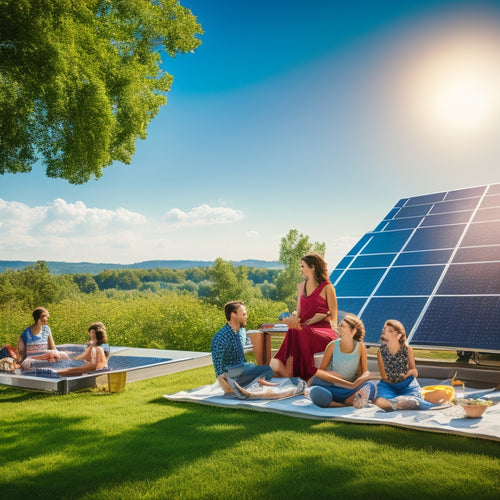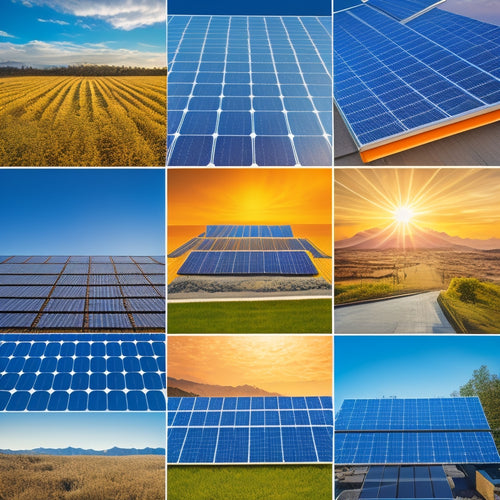
5 Steps to Installing a Solar System in Your House
Share
You'll start by evaluating your energy needs, gathering past utility bills to calculate average daily energy usage in kWh, and identifying patterns and peak usage periods. Next, you'll choose the right equipment, selecting solar panels and inverters that meet your needs and budget. Then, prepare your roof and house by conducting a thorough roof inspection, trimming tree branches, and verifying electrical panel capability. After that, install the solar panels, following manufacturer's instructions and local building codes. Finally, connect to the grid, meeting utility company requirements and adhering to specific safety standards - and you'll be well on your way to utilizing the power of the sun.
Key Takeaways
- Assess your energy needs by gathering past utility bills and identifying patterns to determine the ideal system size and configuration.
- Choose the right equipment, including solar panels, inverters, and battery storage systems, based on your budget, needs, and efficiency ratings.
- Prepare your roof and house by conducting a thorough inspection, verifying electrical panel capability, and trimming tree branches to prevent shading.
- Install the solar panels using a secure mounting system, following manufacturer's instructions and local building codes, and achieving clean energy generation.
- Connect to the grid by meeting utility company requirements, adhering to safety standards, and configuring the system to synchronize with grid frequency and voltage.
Assess Your Energy Needs
How much energy does your household actually consume? Understanding your energy consumption is essential to determining the size and type of solar system you need.
You'll want to gather your past utility bills to calculate your average daily energy usage in kilowatt-hours (kWh). This will help you identify patterns and peak usage periods. Be sure to account for any energy-intensive appliances or systems, such as air conditioning or electric water heaters.
Once you have a clear depiction of your energy consumption, you can start exploring solar incentives that can help offset the cost of your system.
Many governments offer rebates, tax credits, or net metering programs that allow you to sell excess energy back to the grid. Knowing your energy needs will also help you determine the ideal system size and configuration to maximize your savings.
Choose the Right Equipment
With your energy needs assessed, you're ready to select the right equipment for your solar system. You'll need to choose solar panels, an inverter, and possibly a battery storage system. There are several solar panel types, including monocrystalline, polycrystalline, and thin-film. Each type has its own efficiency ratings and installation costs.
| Equipment | Efficiency Rating | Installation Cost |
|---|---|---|
| Monocrystalline Solar Panels | 20-22% | $2.50-$3.50 per watt |
| Polycrystalline Solar Panels | 15-18% | $2.00-$3.00 per watt |
| Thin-Film Solar Panels | 7-14% | $1.50-$2.50 per watt |
When selecting an inverter, you'll need to choose between string inverters, microinverters, and power optimizers. Battery storage systems can provide backup power during outages and enhance your energy usage. Consider maintenance tips, such as cleaning your solar panels regularly, to guarantee ideal performance. By choosing the right equipment, you'll be able to maximize your energy output and reduce your installation costs.
Prepare Your Roof and House
Before installing your solar system, you'll need to confirm your roof and house are ready for the upgrade. A thorough roof inspection is vital to guarantee your roof can support the weight of the solar panels.
You'll want to check for damaged, missing, or loose tiles, as well as signs of wear around chimneys, vents, and skylights. Any necessary repairs should be made before proceeding.
Additionally, you'll need to verify your roof's structural integrity to confirm it can handle the added weight of the solar system. This may involve consulting with a structural engineer or designer, especially if you have an older home or unique roof design.
Next, you'll need to prepare your house's electrical system. This includes verifying your electrical panel is capable of handling the increased power output from the solar system.
You may need to upgrade your panel or add a subpanel to accommodate the additional electricity.
Finally, you should trim any tree branches or shrubs that may be obstructing sunlight or creating shade on your roof.
Install the Solar Panels
What's the most critical aspect of your solar system installation? It's the installation of the solar panels themselves. This is where the magic happens, and you start generating clean energy for your home.
You've got two primary solar panel types to choose from: monocrystalline and polycrystalline. Monocrystalline panels are more efficient but pricier, while polycrystalline panels are more affordable but slightly less efficient. Consider your budget and energy needs when making your decision.
When it comes to installation techniques, you've got two options: roof-mounted and ground-mounted. Roof-mounted systems are more common and require less space, while ground-mounted systems offer more flexibility and ease of maintenance. Verify your chosen technique aligns with your roof's size, shape, and structure.
Now, it's time to get hands-on. Begin by securing the mounting system to your roof, then carefully install the solar panels.
Make certain to follow the manufacturer's instructions and local building codes. You're one step closer to utilizing the power of the sun and reducing your reliance on the grid.
Connect to the Grid
You've successfully installed your solar panels, and now it's time to connect them to the grid. This step requires careful planning and attention to detail to guarantee a safe and efficient connection.
First, you'll need to meet your utility company's requirements for grid connection, which typically involve installing a net meter and adhering to specific safety standards. Net metering allows you to sell excess energy back to the grid and offset your energy consumption.
Next, you'll need to configure your system to synchronize with the grid's frequency and voltage. This typically involves installing a grid tie inverter, which converts the DC power from your solar panels to AC power that matches the grid's specifications.
Be sure to follow the manufacturer's instructions and local electrical codes to guarantee a safe and compliant installation.
Frequently Asked Questions
How Long Does a Typical Solar Panel System Last?
You can expect a typical solar panel system to last around 25-30 years, with some manufacturers offering warranties up to 40 years, provided you perform regular maintenance, like cleaning and inspections, to guarantee peak energy production and extend its lifespan.
Are Solar Panels Resistant to Hail and Extreme Weather?
You'll be relieved to know that most solar panels are designed to withstand hail damage and extreme weather conditions, boasting impressive weather durability ratings, ensuring your system remains operational even in the face of harsh environmental elements.
Can I Install Solar Panels on a Metal Roof?
You can install solar panels on a metal roof, leveraging its advantages like durability and water-tightness, but be prepared to tackle installation challenges like specialized mounting systems and precise waterproofing to guarantee a secure and efficient setup.
Do Solar Panels Still Work During a Power Outage?
You're probably wondering if your solar panels will abandon you during a power outage, leaving you in the dark ages - but fear not! They'll still generate power, albeit at reduced efficiency, and with a backup power system, you'll have a reliable energy safety net.
Are There Any Local or National Incentives for Solar Installation?
You'll be pleased to know that yes, there are incentives for going solar! You're eligible for federal tax credits, covering up to 26% of your installation costs, and state rebates that vary by location, offering additional savings.
Conclusion
You've taken the final step in utilizing the power of the sun. Now, you might be thinking, "But what about the upfront cost?" Yes, investing in a solar system can be expensive, but consider it a long-term investment in your home's value and the planet's future. With the money you'll save on energy bills and the potential increase in your property's value, it's a decision that will pay off in the long run. You've made a smart choice, and it's time to start reaping the benefits.
Related Posts
-

How Solar Panels Reduce Electricity Bills
Solar panels can drastically cut your electricity bills by utilizing sunlight to generate your own energy. This decre...
-

Solar Power Savings for Environmentally Aware Consumers
Switching to solar power lets you drastically cut your carbon footprint while saving money in the long run. Each kilo...
-

Comparative Analysis of Top Solar Brands
To conduct a comparative analysis of top solar brands, focus on key metrics like durability, energy efficiency, and s...


